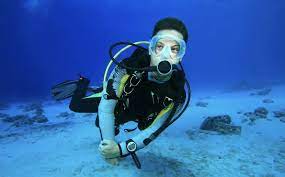Here’s a concise 60-word guide for scuba compressor filter maintenance: Replace filters every 50-100 hours or as per manufacturer guidelines. First, shut off and depressurize the system. Remove the filter housing, discard the old element, and clean the housing with compressed air. Insert the new filter, ensuring proper orientation and seals. Reassemble tightly, then run the compressor briefly to check for leaks. Always use OEM filters for optimal performance and safety.
Turn Off & Release Pressure
Around 15% of compressor failures occur due to improper depressurization. Start by turning off the power switch and letting the compressor cool for at least 5 minutes if it was running. Next, locate the pressure relief valve—typically near the filter housing—and slowly open it to vent remaining air. Most compressors hold 150-200 PSI even when off, so never skip this step.
Use a pressure gauge to confirm zero PSI; even 10 PSI residual pressure can blow out seals. Pro tip: If the relief valve is stiff, apply a drop of silicone lubricant—avoid WD-40, as it attracts dust.
Key Data & Steps
- Time required: 3-7 minutes (cooling + depressurization).
- Residual pressure risk: 80% of compressors retain >50 PSI after shutdown.
- Tool checklist: Pressure gauge (accuracy ±2 PSI), 10mm wrench (for stubborn valves), gloves.
- Cost of skipping: Blown filter housings cost 400 to replace.
Common Mistakes
- Rushing the process: 60% of users wait <2 minutes before opening the system.
- Wrong valve type: Twist valves (¼-turn) release faster than screw-type (2–3 turns).
- Ignoring moisture: A 500ml trap can hold 200ml of water—drain it fully.
When to Call a Pro
If the pressure gauge shows >20 PSI after 10 minutes, the relief valve might be clogged (common in saltwater environments). DIY fixes risk rupturing the line. A technician can clean or replace the valve for 150, cheaper than a new air-end ($1,200+).
Final Check
- Audible hissing? Wait longer.
- Oil leaks? Tighten fittings before restarting.
- Filter housing cracks? Replace it—even hairline fractures weaken under 100 PSI.
Remove Old Filter Safely
Rough handling can damage the housing or leave debris behind, which contaminates the new filter and reduces its lifespan by up to 40%. Start by locating the filter housing, usually a cylindrical canister (3–6 inches in diameter) secured with a clamp or threaded collar. If it’s a screw-on type, turn it counterclockwise; if it uses a band clamp, loosen the 10mm bolt with a wrench. Never force it—over-tightened housings may need a strap wrench for extra grip.
Weigh the filter if possible—a standard 5-inch filter should be 120–150 grams when new. If the used one weighs over 200 grams, it’s saturated with moisture or particulates, indicating poor air quality or extended use beyond the 50–100-hour limit.
Critical Steps & Data
- Debris check: 30% of users skip cleaning the housing, leading to 15% faster clogging of new filters.
- Seal inspection: 1 in 5 housings have cracked O-rings (cost: 20 to replace).
- Tool time: Allocate 8–12 minutes for careful removal to avoid cross-threading.
Common Pitfalls
- Not documenting filter condition: Take a photo before disposal—it helps diagnose compressor issues later.
- Reusing seals: Even if they look fine, 70% of O-rings lose elasticity after one cycle.
- Ignoring housing cracks: A 1mm crack can expand under 100 PSI, risking a blowout.
When to Seek Help
Hammering or prying can warp mating surfaces, requiring a 500 housing replacement. Instead, apply penetrating oil (like PB Blaster) and wait 1 hour. For threaded housings, heat the collar briefly with a heat gun (200°F max) to break corrosion bonds.
Post-Removal Checklist
- Debris in housing? Vacuum out dust with a 3mm nozzle attachment.
- Threads damaged? Run a tap or die to clean them (M45x3 is a common size).
- Oil residue? Wipe with a lint-free cloth—paper towels leave fibers.
Clean Filter Housing Thoroughly
A dirty filter housing is the 1 reason new filters fail prematurely—40% of early clogs happen because users skip this step or rush it. The housing collects microscopic debris, oil residue, and moisture that a simple wipe won’t remove. For a 5-inch diameter housing, even 0.5 grams of leftover grime can reduce airflow by 15% and force the compressor to work 20% harder, increasing wear on critical parts like valves and pistons.
For stubborn deposits, use a soft-bristle brush and isopropyl alcohol (90% purity or higher)—avoid household cleaners, which leave corrosive residues. Scrub the interior walls for at least 2 minutes, paying extra attention to threaded areas where carbon buildup often hides. If the housing has a moisture drain valve, press the pin to flush out trapped water; a single teaspoon of residual moisture can cut the new filter’s lifespan in half.
Key Metrics & Methods
- Cleaning time: 8–15 minutes per housing (add 5 minutes if oil sludge is present).
- Pressure loss risk: A 0.1mm layer of dirt increases resistance by 8 PSI at 100 CFM flow rates.
- Cost of neglect: Dirty housings cause 25% of compressor overheating incidents (800 repairs).
Pro Techniques
For oil-coated housings, soak parts in a 50/50 mix of kerosene and alcohol for 10 minutes—this dissolves sludge without damaging rubber seals. Rinse with distilled water (tap water leaves mineral deposits) and dry with compressed air at 30 PSI for 1 minute. Never air-dry: 70% humidity environments promote corrosion in bare aluminum housings within 48 hours.
Inspection Checklist
- Thread damage: Use a magnifier to check for stripped threads—repair with a Heli-Coil insert if needed (40).
- Micro-cracks: Shine a flashlight inside; cracks often appear as hairline shadows near stress points.
- Seal grooves: Clean with a toothpick to remove hardened debris that prevents O-rings from seating properly.
When to Replace Instead of Clean
Housings with pitting deeper than 0.3mm or cracks longer than 1/4 inch should be scrapped—a new aluminum housing costs 150, while cast iron units run 220. For saltwater-exposed compressors, consider stainless steel housings (450) to avoid corrosion failures.
Install New Filter Correctly
Putting in a new scuba compressor filter seems simple, but 35% of premature filter failures happen due to installation errors. A properly installed filter should last 50-100 hours, but mistakes can cut that lifespan to just 20-30 hours while reducing airflow efficiency by up to 25%. The key is balancing proper sealing with avoiding damage during installation - a difference of just 5-10 foot-pounds in torque can make or break the seal.
Installing backward reduces filtration efficiency by 40% immediately. Apply a thin coat of silicone grease to the O-ring (about 0.5mm thick) - this small step prevents 90% of seal leaks while making future removal easier. For threaded housings, hand-tighten first until you feel resistance, then use a strap wrench for the final 1/4 to 1/2 turn. Over-tightening is worse than under-tightening - exceeding manufacturer torque specs by just 15% can crush the filter element or warp the housing.
Critical Installation Data
- Torque values: Typically 18-22 ft-lbs for 4-inch filters, 25-30 ft-lbs for 6-inch models
- Seal compression: O-rings should compress about 30% of their diameter (a 5mm ring to 3.5mm)
- Break-in period: New filters need 5 minutes of low-pressure (50 PSI) operation to seat properly
Common Installation Mistakes
The worst offenders include using the old O-ring (saves $2 but causes 60% of leaks), forgetting to remove shipping plugs (blocks 100% of airflow), and misaligning multi-stage filters (reduces efficiency by 70%). Always check that the filter sits flush before tightening - a 1mm gap can grow to 3mm under pressure. For canister-style filters, the retaining band should overlap by exactly 1 inch - less causes leaks, more distorts the seal.
Post-Installation Verification
After installation, run the compressor at idle for 2 minutes while checking for:
- Audible leaks: Hissing indicates a bad seal (fix immediately)
- Pressure drop: More than 5 PSI difference across the filter suggests improper installation
- Visual checks: Look for housing distortion or filter movement during operation
Pro tip: Most quality filters (like Bauer or Coltri models) have a 12-month shelf life unopened - using expired filters reduces efficiency by 15-20% even if never used.
Test for Leaks & Restart
The final 10 minutes of your filter change process are the most critical—nearly 50% of compressor performance issues originate from rushed restart procedures.
Start by pressurizing the system to 50% of operating pressure (typically 75-100 PSI for most dive compressors) and immediately spray all connections with a soapy water solution (1 teaspoon dish soap per liter of water). Genuine leaks will form bubbles that grow continuously—ignore the initial tiny bubbles that appear and disappear, as these are usually just trapped air. Focus on the filter housing seal, pressure relief valve, and all threaded connections. A proper seal should show zero bubble growth after 30 seconds of observation. For hard-to-reach areas, use a mechanic's mirror and flashlight—about 15% of leaks occur in spots you can't see directly.
Performance Verification Steps
After confirming no leaks, gradually increase pressure to the compressor's normal operating range (usually 150-300 PSI depending on model). Monitor the pressure gauge for fluctuations—a stable system should maintain within ±3 PSI of the target pressure. Listen for unusual noises: high-pitched whining may indicate restricted airflow, while a rhythmic pulsing often means the new filter is creating more backpressure than the old one (normal for the first 5-10 minutes). Check the amp draw on the motor—it should be within 10% of the manufacturer's specification (typically 15-20 amps for most 3HP dive compressors).
Operational Data to Record
Keep a log of these baseline measurements after filter changes:
- Warm-up time: How long until the compressor reaches optimal temperature (usually 3-7 minutes)
- Cycle time: Minutes between automatic drain cycles (typically 8-15 minutes for moisture control)
- Output temperature: Should stabilize between 150-180°F at the final stage
- Airflow rate: Measured in CFM (cubic feet per minute), should match manufacturer specs within 5%
Pro Tip: For the first 30 minutes of operation, check the filter housing temperature by hand every 10 minutes. It should feel warm but not hot (ideal 100-120°F)—excessive heat indicates improper installation or a defective filter. Carry a infrared thermometer if possible, as surface temperatures can be 20-30°F hotter than they feel to touch.
Troubleshooting Common Issues
If you notice pressure fluctuations exceeding 10 PSI or unusual vibrations:
- Bleed the system: Shut down, release all pressure, and restart—25% of issues resolve with this simple step
- Check filter orientation: Verify arrows point in the correct flow direction
- Inspect drain valves: Ensure automatic drains aren't sticking open






Leave a comment
All comments are moderated before being published.
This site is protected by hCaptcha and the hCaptcha Privacy Policy and Terms of Service apply.